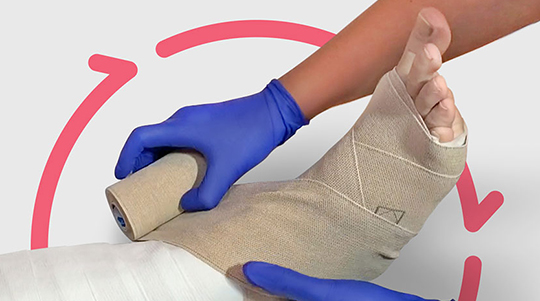Why compression therapy is more complex than it may seem
10 must-try recommendations from wound care experts to help improve outcomes.

Compression therapy is considered the gold standard for preventing and treating venous leg ulcers and the underlying venous stasis disease. But studies show caregivers often lack experience and knowledge to achieve the proper therapeutic compression, and patients often find the wraps uncomfortable, leading to lower adherence to treatment. In the end, many candidates for compression therapy aren’t getting what they need to heal.1
Our own Medline wound care clinicians have been in the field helping guide caregivers to follow compression best practices. Here, we share some of the key insights they’ve gained during these sessions:
It’s important for caregivers to understand the “why” behind venous stasis.
Although many clinicians have experience in compression therapy, they might not be fully aware of the physical changes caused by chronic venous disease. “It’s been an eye opener when we explain to them that compression is for more than just squeezing out fluid—for example, that it pushes the venous valves together for better blood flow,” says Cristine Ray, BSN, RN, CWON, Medline Clinical Nurse Specialist.
Proximity to expertise helps ensure best practices.
The further away caregiving gets from the hospital setting, the sparser the knowledge base—especially in the home care setting. “Those in the home health setting need more knowledge, but they have less access to experts, and they don’t get enough practice to really feel comfortable applying a wrap,” Ray says.
Lack of confidence might keep caregivers from engaging.
When clinicians lack the proper skills or practice time, they may be afraid they’ll hurt a patient with compression by doing it wrong. “They’re afraid because this is something that can definitely cause patient harm if it’s not done correctly,” says Dawn Fortna, MSed, RN, CWOCN, Medline Clinical Nurse Educator.
10 compression therapy tips caregivers need to know
Check out these 10 recommendations from our clinical experts to help fill some of the knowledge gaps and overcome the barriers to improving patient outcomes:
- Be certain you have the right diagnosis before treating a patient with compression therapy. At minimum, clinicians should know the patient’s ankle brachial index (ABI). Non-invasive vascular studies, such as a perfusion assessment or venous ultrasound, are also a good idea. “Many, many patients who have a venous deficiency have an arterial element, but whether it’s enough to stop the compression, we don’t know until different tests are done,” Ray says. “Arterial testing has to be done to exclude those patients.”
- Explore evidence-based practices by following the three essential steps when caring for patients with VLU:
- Control the swelling caused by venous stasis.
- Treat venous leg ulcers.
- Engage patients in their care.
- Standardize care with innovative tools and strategies that fight barriers to healing and support the success of the clinician, patient and family members or caregivers.
- Choose a wrap with an intuitive accuracy indicator, such as COMPRECARES™, which makes it easier to achieve compression accuracy and standardize treatment.
- Schedule a compression therapy workshop, especially for clinicians who do not have access to wraps with accuracy indicators, to help develop their skills and confidence applying compression wraps.
- Consider using a two-layer wrap. Clinicians can more easily gauge proper stretch at a glance when using a two-layer product such as AccuWrap™. They take less time than three- and four-layer wraps to apply correctly—an advantage amid persistent staff shortages. In addition to decreasing time for compression wrapping, a two-layer product can also help increase patient adherence.
- Choose a super absorbent wound dressing, such as OptiLock, to manage wound exudate and protect skin from maceration that can prevent healing. The right dressing can handle a large quantity of fluid and serve as a barrier between an open wound and the wrap.
- Remove a wrap immediately if a patient reports pain and consult with a wound care expert. Patients should not take painkillers, as it may mask pain caregivers need to know about. Also be careful to distinguish whether the patient is experiencing pain or typical discomfort. For instance, if a patient is complaining that the wrap is too bulky or hot, which often is the case especially in warm climates, help explain that this is normal and encourage the patient to leave the wrap on.
- Educate patients on at-home care. Take time to reinforce to patients that compression is a lifelong treatment and does not cure the problem of the underlying venous stasis disease—rather, it controls the symptoms.
- Participate in educational workshops and webinars to learn the physiology of venous stasis and VLU, how compression therapy works, proper application and product innovations that make treatment easier and more effective.
Key takeaway
Compression therapy poses a lot of challenges for clinicians—from limited knowledge about venous stasis and VLUs and lack of experience treating them to confusion about the right products and the best way to apply them. Medline works with its customers to educate and support caregivers with a variety of world-class educational resources, such as complimentary access to online courses, an expert hotline and data-tracking tools.
References:
- Harding, K. (2016). Challenging passivity in venous leg ulcer care – the ABC model of management. International Wound Journal, 13(6), 1378–1384. Available at https://doi.org/10.1111/iwj.12608




